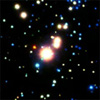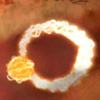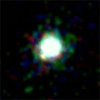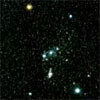CXC Home | Search | Help | Image Use Policy | Latest Images | Privacy | Accessibility | Glossary | Q&A
A Multiwavelength Look At Orion
Quicktime MPEG This sequence begins with Chandra's image of the Orion Nebula Cluster, the deepest X-ray image ever obtained of a star cluster. The image contains over 1,600 X-ray sources, most of them young stars. Zooming into a smaller region at the cluster's center, the view then dissolves to an optical image from the Hubble Space Telescope of the same region, followed by an infrared image made by ESO's Very Large Telescope, before returning to the Chandra data.
[Runtime: 0:20]
(Credit: X-ray: NASA/CXC/Penn State/E.Feigelson & K.Getman et al.
Optical: NASA/STScI/Rice University/C.O'Dell et al.
Infrared: ESO/VLT/M.McCaughrean et al.)
Field Guide: Normal Stars & Star Clusters
Quicktime MPEG This sequence begins with Chandra's image of the Orion Nebula Cluster, the deepest X-ray image ever obtained of a star cluster. The image contains over 1,600 X-ray sources, most of them young stars. Zooming into a smaller region at the cluster's center, the view then dissolves to an optical image from the Hubble Space Telescope of the same region, followed by an infrared image made by ESO's Very Large Telescope, before returning to the Chandra data.
[Runtime: 0:20]
(Credit: X-ray: NASA/CXC/Penn State/E.Feigelson & K.Getman et al.
Optical: NASA/STScI/Rice University/C.O'Dell et al.
Infrared: ESO/VLT/M.McCaughrean et al.)
Field Guide: Normal Stars & Star Clusters
Animation of X-ray Flares from a "Young Sun"
Quicktime MPEG This animation shows how X-ray flares from a young star affect a planet-forming disk. Light from the young star is reflected off the inner part of the disk, making it glow. The view zooms in to show small white flares continually erupting on the surface of the young star. A set of huge white magnetic loops then erupts from the star and hits the inside edge of the disk, resulting in an extremely bright flare. X-rays from the flare then heat up the planet-forming disk and will later result in turbulence that affects the positions of planets.
[Runtime: 0:23]
(Animation: NASA/CXC/A.Hobart)
View Still Images
Quicktime MPEG This animation shows how X-ray flares from a young star affect a planet-forming disk. Light from the young star is reflected off the inner part of the disk, making it glow. The view zooms in to show small white flares continually erupting on the surface of the young star. A set of huge white magnetic loops then erupts from the star and hits the inside edge of the disk, resulting in an extremely bright flare. X-rays from the flare then heat up the planet-forming disk and will later result in turbulence that affects the positions of planets.
[Runtime: 0:23]
(Animation: NASA/CXC/A.Hobart)
View Still Images
Time-Lapse Movie of Chandra Observations
Quicktime MPEG Zooming in from the full X-ray image, this sequence shows a time-lapse movie of Chandra data covering a smaller region of the Orion Nebula. Rapid variations in the young Orion stars can be seen during this 7-day-long observation (half the full Chandra observation) which contains 50 X-ray images. The star at the center of the image shows the strongest flare recorded among 30 stars with masses close to that of the Sun. This flare is about 10,000 times more powerful than the biggest flares seen on the Sun. If the Sun were placed at the distance of the Orion Nebula, its largest flares would not be visible in this movie.
[Runtime: 0:16]
(Credit: NASA/CXC/Penn State/E.Feigelson & K.Getman et al.)
Quicktime MPEG Zooming in from the full X-ray image, this sequence shows a time-lapse movie of Chandra data covering a smaller region of the Orion Nebula. Rapid variations in the young Orion stars can be seen during this 7-day-long observation (half the full Chandra observation) which contains 50 X-ray images. The star at the center of the image shows the strongest flare recorded among 30 stars with masses close to that of the Sun. This flare is about 10,000 times more powerful than the biggest flares seen on the Sun. If the Sun were placed at the distance of the Orion Nebula, its largest flares would not be visible in this movie.
[Runtime: 0:16]
(Credit: NASA/CXC/Penn State/E.Feigelson & K.Getman et al.)
Constellation View of the Orion Nebula
Quicktime MPEG This motion graphic starts with a wide-field, ground-based optical image of the Orion constellation. Next, the view zooms into an optical photograph taken by David Malin of the Orion Nebula before dissolving into a mosaic of Hubble Space Telescope images of a slightly smaller region. The sequence ends with Chandra's image of the Orion Nebula Cluster, the deepest X-ray image ever obtained of a star cluster.
[Runtime: 0:28]
(Credit: Ground-based: Akira Fujii; Optical Photograph: Copyright Anglo-Australian Observatory. Photograph by David Malin; HST: NASA/STScI/Rice Univ./C.O'Dell et al.; X-ray: NASA/CXC/Penn State/E.Feigelson & K.Getman et al. Animation Credit: NASA/STScI/Bryan Preston)
Quicktime MPEG This motion graphic starts with a wide-field, ground-based optical image of the Orion constellation. Next, the view zooms into an optical photograph taken by David Malin of the Orion Nebula before dissolving into a mosaic of Hubble Space Telescope images of a slightly smaller region. The sequence ends with Chandra's image of the Orion Nebula Cluster, the deepest X-ray image ever obtained of a star cluster.
[Runtime: 0:28]
(Credit: Ground-based: Akira Fujii; Optical Photograph: Copyright Anglo-Australian Observatory. Photograph by David Malin; HST: NASA/STScI/Rice Univ./C.O'Dell et al.; X-ray: NASA/CXC/Penn State/E.Feigelson & K.Getman et al. Animation Credit: NASA/STScI/Bryan Preston)
Return to Orion Nebula (10 May 05)






